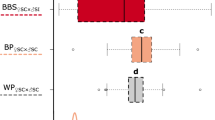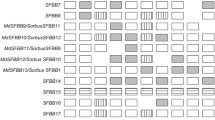Summary
It has been reported that incomplete self-incompatibility could be determined in Borago officinalis by many genes. Simple ten-gene models for such enforced cross-fertilization have been developed and their properties examined by computer simulation. Mutation rates necessary to maintain a given level of variability in small populations are high, as already determined theoretically for oligogenic self-incompatibility systems. However, the extent of ineffective pollination is very much greater in the ten-gene system. This finding may be verifiable in borage if it is indeed self-incompatible.
Similar content being viewed by others
References
Bateman AJ (1952) Self-incompatibility systems of angiosperms. Heredity 6:285–310
Charlesworth D (1988) Evolution of homomorphic sporophytic self-incompatibility. Heredity 60:445–453
Crowe LK (1971) The polygenic control of outbreeding in Borago officinalis L. Heredity 27:111–118
Fisher RA (1958) The genetical theory of natural selection, 2nd ed. Dover, New York
Leach CR, Hayman DL (1987) The incompatibility loci as indicators of conserved linkage in the Poaceae. Heredity 58:303–305
Lundqvist A (1956) Self-incompatibility in rye 1. Genetic control in the diploid. Hereditas 42:293–348
Lundqvist A, Østerbye U, Larsen K, Linde-Laursen I (1973) Complex self-incompatibility systems in Ranunculus acris L. and Beta vulgaris. Hereditas 74:161–168
Mayo O (1966) On the problem of self-incompatibility alleles. Biometrics 22:111–120
Mayo O (1971) Rates of change in gene frequency in tetrasomic organisms. Genetica 42:329–337
Mulcahy DL, Mulcahy GB (1983) Gametophytic self-incompatibility re-examined. Science 220:1247–1251
Østerbye U (1975) Self-incompatibility in Ranunculus acris L. and Beta vulgaris. Hereditas 74:161–168
Østerbye U (1986) Self-incompatibility in Ranunculus acris L. IV. Pseudo-compatibility. Hereditas 104:131–144
Penrose LS (1969) Effects of additive genes at many loci compared with those of a set of alleles at one locus on parent-child and sib-sib correlations. Ann Hum Genet 33:15–21
Warren JM, Crawford TJ, Oxford GS (1988) Inhibition of self-pollination germination in Senecio vulgaris L. Heredity 60:33–38
Author information
Authors and Affiliations
Additional information
Communicated by H.F. Linskens
Rights and permissions
About this article
Cite this article
Mayo, O., Leach, C.R. Quantitatively determined self-incompatibility. Theoret. Appl. Genetics 77, 375–378 (1989). https://doi.org/10.1007/BF00305831
Received:
Accepted:
Issue Date:
DOI: https://doi.org/10.1007/BF00305831




